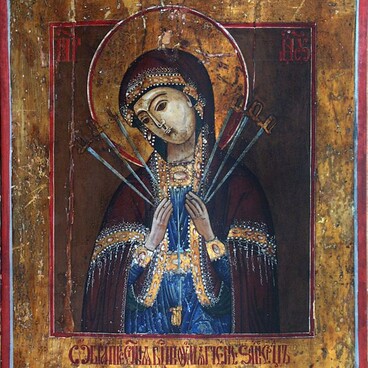The icon shows the Mother of God with her hands raised in a prayer. On her chest is a waist-length image of Christ Emmanuel with the blessing hand and a rolled-up scroll in his left hand. Along the borders, a master depicted figures of Saints Nicholas the Wonder-Worker and Mary of Egypt, the patroness of penitent women. Golden openwork décor frames the main images of the icon and separates them from the borders.
The icon was created by a highly skilled artist. The artist meticulously followed and repeated the composition of the first Tobolsk icon of the Theotokos of Abalak. It means that the author of the Tomsk icon personally saw a copy of the lost ancient monument. Copies of revered icons are called ‘spiski’ in Russian — they are given the same name as the original.
Such manner of painting faces is characteristic of the monuments of Mount Athos: they are very expressive and seem to be shrouded in a matt haze. For more than ten centuries Mount Athos in Greece has remained the spiritual center for all Orthodox Christians. The local icon painting workshop has grown into an independent art school.
The Athos oil painting technique is smooth and at the same time multi-layered. The faces and hands are painted in the glazing technique: light strokes of diluted, semi-transparent paint are applied over the main color. This technique gives the image a special softness and glow. The faces of the Queen of Heaven and the Mother of God are much darker than the figures of the saints: the master painted them following the Tobolsk icon. The icon is also characterized by soft tonal transitions from one layer of color to another, from conditional shadow to conditional light. Despite the contrast of three-dimensional images and a flat decorative background, the author managed to create a proportional composition. The faces of St. Nicholas and St. Mary of Egypt are executed in a similar picturesque manner, but in a much lighter color scheme.
Athos masters paid special attention to clothes and draperies. The artist painted the robes of the Virgin Mary, as if admiring the textures of different types of fabric. The draperies of the cherry maforium (long cloak) with gold powder colors and green lining seem to tremble. The fabric of the maforium resembles satin Chinese shawls that appeared in Siberia with the start of the Russian-Chinese caravan trade. The blue dress of the Virgin with a collar and cuffs (armlets) made of gold leaf, studded with large pearls, shimmers with festive velvet. The same pearls are lined with three stars of the perpetual virginity of Mary, indicating that Mary preserved her purity and innocence even after the birth of Christ.
The icon from the Tomsk collection was probably created as a free interpretation of the famous miraculous Abalak icon, only the size is much larger. It is possible that it was painted at a workshop of a student of Mount Athos icon painters. Announcements about such workshops are found in the publications of ‘Eparkhialnye vedomosti’ (‘Eparchial News’) of various Siberian cities.
The icon was created by a highly skilled artist. The artist meticulously followed and repeated the composition of the first Tobolsk icon of the Theotokos of Abalak. It means that the author of the Tomsk icon personally saw a copy of the lost ancient monument. Copies of revered icons are called ‘spiski’ in Russian — they are given the same name as the original.
Such manner of painting faces is characteristic of the monuments of Mount Athos: they are very expressive and seem to be shrouded in a matt haze. For more than ten centuries Mount Athos in Greece has remained the spiritual center for all Orthodox Christians. The local icon painting workshop has grown into an independent art school.
The Athos oil painting technique is smooth and at the same time multi-layered. The faces and hands are painted in the glazing technique: light strokes of diluted, semi-transparent paint are applied over the main color. This technique gives the image a special softness and glow. The faces of the Queen of Heaven and the Mother of God are much darker than the figures of the saints: the master painted them following the Tobolsk icon. The icon is also characterized by soft tonal transitions from one layer of color to another, from conditional shadow to conditional light. Despite the contrast of three-dimensional images and a flat decorative background, the author managed to create a proportional composition. The faces of St. Nicholas and St. Mary of Egypt are executed in a similar picturesque manner, but in a much lighter color scheme.
Athos masters paid special attention to clothes and draperies. The artist painted the robes of the Virgin Mary, as if admiring the textures of different types of fabric. The draperies of the cherry maforium (long cloak) with gold powder colors and green lining seem to tremble. The fabric of the maforium resembles satin Chinese shawls that appeared in Siberia with the start of the Russian-Chinese caravan trade. The blue dress of the Virgin with a collar and cuffs (armlets) made of gold leaf, studded with large pearls, shimmers with festive velvet. The same pearls are lined with three stars of the perpetual virginity of Mary, indicating that Mary preserved her purity and innocence even after the birth of Christ.
The icon from the Tomsk collection was probably created as a free interpretation of the famous miraculous Abalak icon, only the size is much larger. It is possible that it was painted at a workshop of a student of Mount Athos icon painters. Announcements about such workshops are found in the publications of ‘Eparkhialnye vedomosti’ (‘Eparchial News’) of various Siberian cities.



